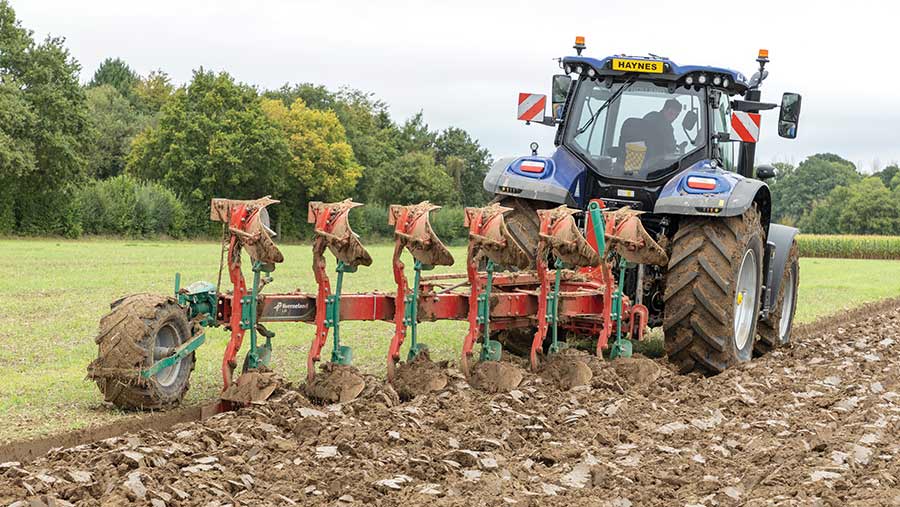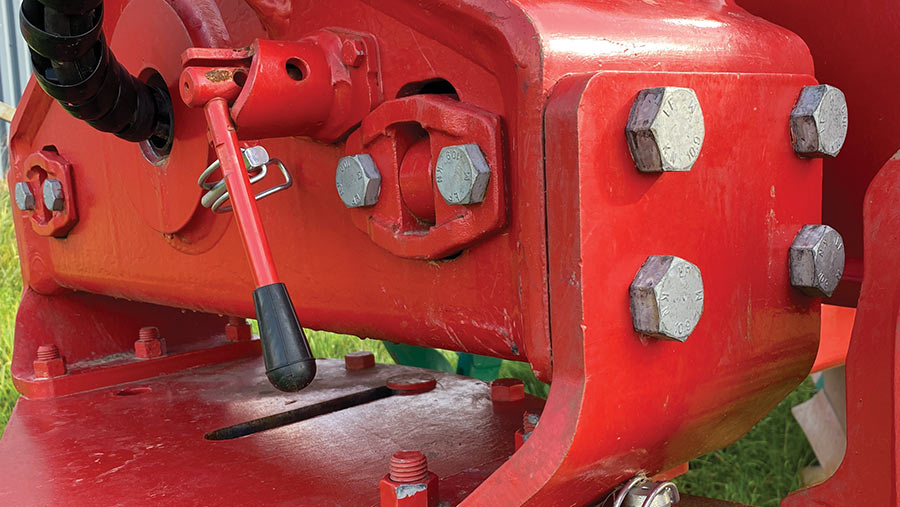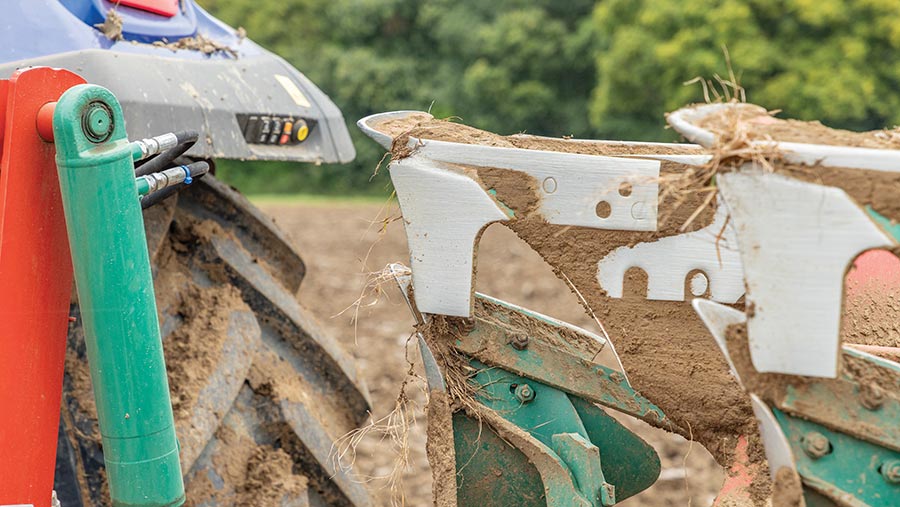On test: Kverneland’s updated six-furrow LO plough
 © Geoff Ashcroft
© Geoff Ashcroft Kverneland has updated its long-serving LO plough range, most notably with a transport kit that promises to have it faithfully following the tractor on the road.
The Trailer Transport System (TTS) was first launched on the isobus-controlled iPlough in 2016, allowing it to track like a trailer around sweeping bends.
To do so, the plough is swung into its butterfly position, dropped onto its rear wheel and freed of its tether to the tractor’s top link.
Removing the two pins that hold the cross-shaft square then leaves the front to pivot through 45deg as the tractor corners.
See also: Why Lincs contractor Rockscape relies on subsoiling toolbar
This reduces the turning circle compared with a plough that is held rigidly to steer on its rear wheel and is far safer than travelling with it hoisted in the air, where one unexpected pothole is liable to send the whole outfit swaying like a drunkard 10 pints deep.
The system is available on the five-, six- and seven-furrow LO models, which are slightly cheaper and less generously specced than the 3400 S range. The price difference, like-for-like, is circa £10,500.
However, like its stablemate, the LO can still be used both in-furrow and, more popularly, on-land.
Switching between these two modes is a simple case of matching the front furrow with the 12-20in range of the other bodies and tweaking the screw-type wing adjusters to keep the plough plumb.

© MAG/Oliver Mark
On land, there should be enough offset to run a tractor on dual wheels should that be necessary and, once the front furrow width has been set, operators can lock off the governing cylinder to ensure the work remains consistent.
However, with our demo New Holland T7 GPS-less, we went old-school and dropped the wheels into the furrow.
If this is to be a common occurrence then it’s worth speccing a turnover sequence valve that will shift the plough into its on-land position before swinging it over.
At £2,463, it’s a pricey but worthwhile investment as the bodies swing over the wheel, causing it to regularly clout the ground and put unnecessary strain on the headstock. Kverneland says it should stand up to the abuse, though.
LO Variomat TTS (as tested)
- Furrows Six
- Mouldboards No 28
- Point-point clearance 85cm (100cm optional)
- Underbeam clearance 80cm
- Spools required Four double-acting
- Extras fitted Landside knives, skimmer extensions
- List price £54,800
- On-farm price £41,400
The short-term fix is to close the plough up prior to turnover – something that can be set in the headland management system of a modern tractor.
No 28 bodies
Our test model was fitted with the firm’s No 28 bodies designed specifically for working behind wide tyres.
The long, gradual curves invert the soil slowly and deliver impressively consistent trash burial and more effective crumbling than the older No 8 design. Their length also means they take less pulling than a shorter board.
Although they will comfortably tidy up behind a 710mm tyre, we found the squishy sidewalls of a very high flexion (VF) fitment had a habit of mushing the furrow wall, so it’s worth running them at slightly higher pressure than would be necessary for on-land work.
As an alternative to the 28s, Kverneland offers a deeper-bodied version – the No 38 – designed primarily for preparing land for potatoes, sugar beet and the like, and a new No 40 slatted body of the same length.
These are protected by standard shear-bolts – for the leaf-sprung auto-reset system buyers will be pointed towards the fancier 3400 S.
And while the S models get the firm’s slick centralised skimmer adjustment, which offers the ability to reposition both left and right sides simultaneously, the LOs have a conventional arrangement with individual bolts that pinch snuggly into recessed notches.
We found it beneficial to run the skimmer in line with the tractor wheels slightly deeper than the rest to ensure it consistently carves off the cleat-marked top layer.
Our top spec model also came with skimmer extensions – relatively crude lengths of metal bar that protrude 280mm to stop trash rolling over the mouldboards – and landside knives.

© Geoff Ashcroft
The latter help slice a neat furrow wall and provide a bit more support against lateral load to keep the plough running straight, particularly when working on-land.
They are significantly cheaper and lighter than discs, which are only necessary for turning over grass leys, and are easily unbolted when not required to save needlessly wearing metal.
The price difference between discs and knives is also substantial, at almost £7,000 (list) for a six-furrow set.
Hydraulic depth wheel
The biggest luxury on LOs is the hydraulic depth wheel, which affords even the most seasoned operator the chance to do a tidier job.
Its position can be altered from the cab and, once its working depth has been set, a tap in the plumbing system allows it to be locked off.
This limits its stroke travel to the desired maximum depth – 8in, for example – in the same way as a set of ram collars.
It can also be exploited to form a squarer start of each bout by powering it down to its shallowest position.
This lets the front few furrows drop into work first, after which the wheel can be returned to its preset position, halving the length of the “in” to leave a less choppy headland.
Doing so should reduce the amount of buried trash re-ploughed on the headland.
To an extent, it’s possible to achieve a similar squared-off result at the end of the bout by making the most of the play in the top link’s elongated slot.
If set correctly, this will see the front of the plough lifted out of the ground a second or two sooner than the back.
Various wheel sizes are available, the biggest of which is the 420/55 R17 seen here. It comes with a full-width scraper that helps keep it clean, though it can still drag rather than roll through wet patches.
We also found its self-locating roller ball turnover mechanism reliant on a regular shot of grease, without which it is liable to seize.

